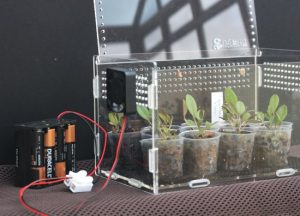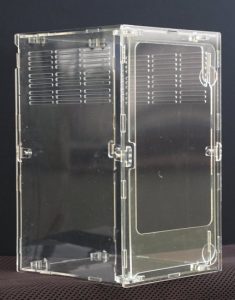Enclosures for small, mini- and micro-orchids
Most of the small, mini- and micro-orchids need high humidity and good air movement, but they do not need high light levels or strong sunshine. Even so, unless they are provided with an enclosure of some sort, they can be difficult to grow in an average home environment … indeed, depending on what orchids you grow, providing appropriate conditions can be equally difficult in an orchid house.
This companion series to my articles ‘The small, the mini- and the micro-orchids’ is intended to offer some suggestions on how acceptable growing conditions can be achieved relatively simply.
I shall assume that you have none of these tiny plants at present and shall begin with what I consider to be the simplest solution, yet one, which is able to accommodate quite a few plants, depending on their size.
The first enclosures I shall mention are marketed as being suitable for housing invertebrates such as arachnids, phasmids, mantises etc. They are available in a small range of sizes, supplied in an easy, self-assembly format and, being made entirely of clear acrylic, they can provide a very suitable environment for your orchids.
I have several of these which I use for quarantining new arrivals and for weaning the tiny seedlings of the mini- and micro-plants. They are inexpensive to buy and are suitable if you only have a few plants. However, apart from the ventilation holes, they have no other means of regulating the internal environment of the enclosure and so you must choose carefully not only the plants that you place in them, but also where you position the enclosures.
|
|
|
Shown here on the left is the first and smallest of the enclosures that I have. Measuring just 11.5 x 11.5 x 20 cms, it should fit on any windowsill or shady place in an orchid house. This one opens at the top. Note that it already has a lot of ventilation holes that can double-up as places to secure mounted plants. The closing device is magnetic, but since the enclosure is held together only by silicone bands, it can easily be dismantled for cleaning if required. However, it is not watertight.
Also illustrated is the same enclosure containing six mini- /micro-orchids, all but one of which is in flower. Plants on mounts hang from the ventilation holes, but I am sure that plants could also be mounted and displayed on small branches, pieces of cork or rock. Humidity is provided by a piece of moisture-retentive fabric in the base, but well-wrung-out sphagnum moss would also be a suitable substitute, leaving no free water to leak from the enclosure. If placed on a window-sill, then the enclosure could stand in a saucer or on a plate.

This enclosure is the same size as the previous one, but is horizontal, with the opening at the top and hinged to the long side. A group of Lepanthes cloesii seedlings has lived in this enclosure for more than six months and seems to be growing well. Despite the small fan unit on the side of the enclosure, the seedlings grew well without it. If you feel that the ventilation holes in this type of enclosure are insufficient for the needs of your plants, you could add one or more of these small fans to the outside, either to push air in or suck it out. The fan shown here is about 38 mm across, but I also have a 25 mm version, both powered by a 12v input, in this case a 12v battery pack. …… More about these later.

This enclosure is similar to the previous ones except that it is held together with screw fixings instead of silicone bands, has a front opening door and at 15.5 x 14.5 X 25 cms, is larger. The extra vertical height will allow you to grow taller plants or those that have a more pendant habit.

Here are the two enclosures, side by side, each containing at least six plants. Plants on mounts are either suspended from the ventilation holes or from a transparent suction cup which has a hole through which a hook can be inserted (one can be seen on the top back of the larger unit). Circulation fans could easily be attached to either if required.
I know that there are many similar units available on the market, as well as other enclosures capable of serving the same purpose, and I hope that you will soon acquire one and start growing mini- /micro-orchids.
In the next article I shall recommend some larger units, together with ideas for controlling environmental factors such as light, heat etc.

